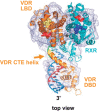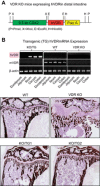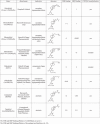Vitamin D: Metabolism, Molecular Mechanism of Action, and Pleiotropic Effects
- PMID: 26681795
- PMCID: PMC4839493
- DOI: 10.1152/physrev.00014.2015
Vitamin D: Metabolism, Molecular Mechanism of Action, and Pleiotropic Effects
Abstract
1,25-Dihydroxvitamin D3 [1,25(OH)2D3] is the hormonally active form of vitamin D. The genomic mechanism of 1,25(OH)2D3 action involves the direct binding of the 1,25(OH)2D3 activated vitamin D receptor/retinoic X receptor (VDR/RXR) heterodimeric complex to specific DNA sequences. Numerous VDR co-regulatory proteins have been identified, and genome-wide studies have shown that the actions of 1,25(OH)2D3 involve regulation of gene activity at a range of locations many kilobases from the transcription start site. The structure of the liganded VDR/RXR complex was recently characterized using cryoelectron microscopy, X-ray scattering, and hydrogen deuterium exchange. These recent technological advances will result in a more complete understanding of VDR coactivator interactions, thus facilitating cell and gene specific clinical applications. Although the identification of mechanisms mediating VDR-regulated transcription has been one focus of recent research in the field, other topics of fundamental importance include the identification and functional significance of proteins involved in the metabolism of vitamin D. CYP2R1 has been identified as the most important 25-hydroxylase, and a critical role for CYP24A1 in humans was noted in studies showing that inactivating mutations in CYP24A1 are a probable cause of idiopathic infantile hypercalcemia. In addition, studies using knockout and transgenic mice have provided new insight on the physiological role of vitamin D in classical target tissues as well as evidence of extraskeletal effects of 1,25(OH)2D3 including inhibition of cancer progression, effects on the cardiovascular system, and immunomodulatory effects in certain autoimmune diseases. Some of the mechanistic findings in mouse models have also been observed in humans. The identification of similar pathways in humans could lead to the development of new therapies to prevent and treat disease.
Copyright © 2016 the American Physiological Society.
Figures










References
-
- Autosomal dominant hypophosphataemic rickets is associated with mutations in FGF23. Nature Genet 26: 345–348, 2000. - PubMed
-
- Abdul Gafor AH, Saidin R, Loo CY, Mohd R, Zainudin S, Shah SA, Norella KC. Intravenous calcitriol versus paricalcitol in haemodialysis patients with severe secondary hyperparathyroidism. Nephrology 14: 488–492, 2009. - PubMed
-
- Adorini L, Penna G, Amuchastegui S, Cossetti C, Aquilano F, Mariani R, Fibbi B, Morelli A, Uskokovic M, Colli E, Maggi M. Inhibition of prostate growth and inflammation by the vitamin D receptor agonist BXL-628 (elocalcitol). J Steroid Biochem Mol Biol 103: 689–693, 2007. - PubMed
Publication types
MeSH terms
Substances
Grants and funding
LinkOut - more resources
Full Text Sources
Other Literature Sources
Medical

